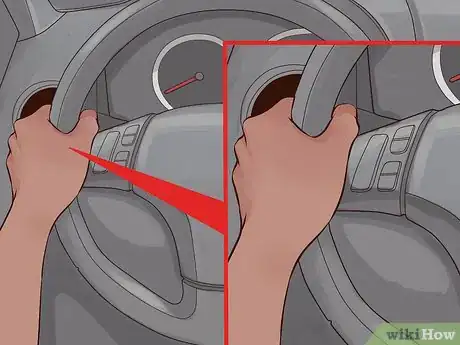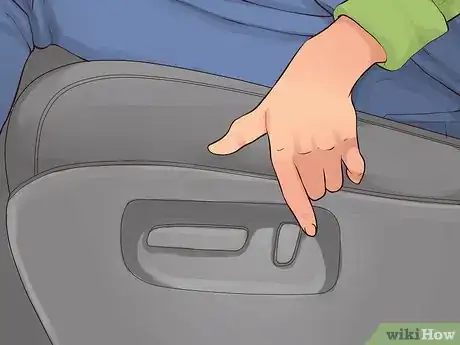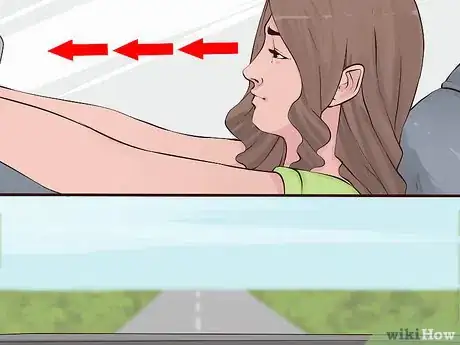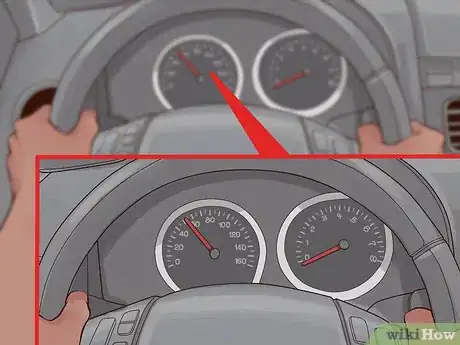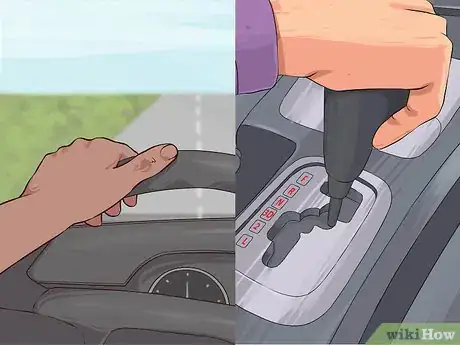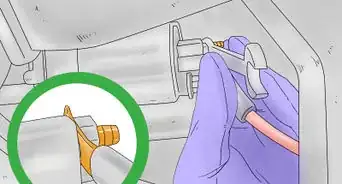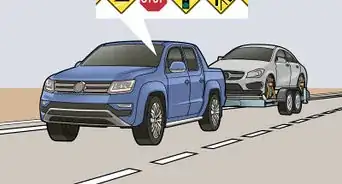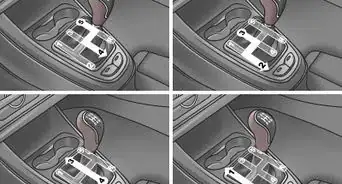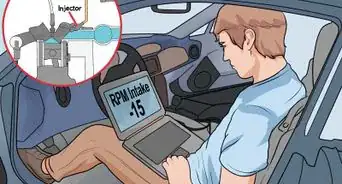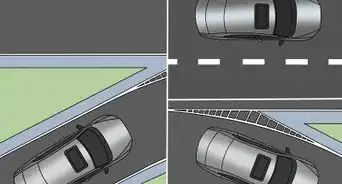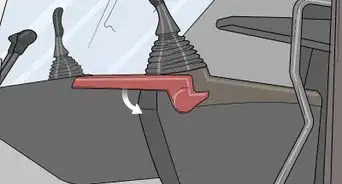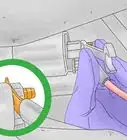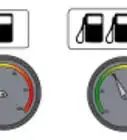This article was co-authored by Ibrahim Onerli. Ibrahim Onerli is a Driving Instructor and the Manager of Revolution Driving School in New York City. His mission is to make the world a better place by teaching safe driving. Ibrahim trains and manages a team of over eight driving instructors. He specializes in teaching defensive driving and stick shift driving.
There are 7 references cited in this article, which can be found at the bottom of the page.
wikiHow marks an article as reader-approved once it receives enough positive feedback. This article received 13 testimonials and 89% of readers who voted found it helpful, earning it our reader-approved status.
This article has been viewed 667,397 times.
Hollywood movie images are full of horrible demonstrations of how to steer a car. No doubt this is because safe steering techniques are visually less dramatic. Keeping both hands on the wheel and keeping both eyes on the road are two key components of safe steering.
Things You Should Know
- Hold the wheel firmly with both hands at the “10-and-2” or “9-and-3” position. Turn the wheel in the direction you wish to turn with both hands.
- To steer in reverse, put your right arm around the passenger seat and your left hand at 12 o’clock on the steering wheel. Look out the rear windshield.
- Adjust the seat so you can sit comfortably and look far down the road ahead of you.
Steps
Holding the Steering Wheel Correctly
-
1Hold the wheel with both hands. Be ready to negotiate split-second emergencies. Maintain as much control as possible over the car at all times. If your car has a manual transmission, shift gears when needed, but do not maintain a needless grip on the gearshift afterward. Instead, return your hand to the steering wheel immediately.[1]
- Turning on your windshield wipers, headlights, and turning signals also require you to remove one hand from the wheel.[2] These controls are typically located close to the steering wheel to minimize the time spent driving one-handed.
- Reversing the car is an exception to this rule.
-
2Keep your grip firm. Resist the urge to slacken your grip on the wheel. At the same time, be careful not to clench the wheel too tensely. This can tire your arms out and possibly obscure warning signs that reverberate through the steering wheel.[3]
- ”Feeling” the car through the steering wheel is another important reason to steer with both hands.
Advertisement -
3Hold the wheel at at "10-and-2" or "9-and-3." Picture the steering wheel as an analogue clock face with 12 o’clock as the apex of the wheel. With your left hand, hold the wheel at either the 9 or 10 o’clock position and hold the other side of the steering wheel at either the 3 or 2 o’clock position with your right hand.[4]
- 10-and-2 is better suited for older cars or any others with larger steering wheels and no power steering.
- 9-and-3 has become the new norm for modern cars equipped with power steering, smaller steering wheels, and airbags.
-
4Mind your thumbs. While driving on paved roads, hold the wheel with your thumbs hooked around the steering wheel. If you turn off-road, remove your thumbs. Place them along the steering wheel's rim, as if you were giving two thumbs-up.[5]
- Hooking your thumbs under the rim while driving off-road may set you up for injury. Your tires could strike obstacles hard enough to jolt the steering wheel in your hand.[6]
- If you are driving on a paved road with your hands at 9-and-3, nestle your thumbs along the wheel's spokes where they meet the rim.
Changing Directions
-
1Start with the push-and-pull technique. Pull the steering wheel down in the direction that you wish to turn (for left turns, pull with your left hand, and vice versa). As you pull the steering wheel down, relax your other hand. Bring it down along the wheel to meet your “pulling” hand above your crotch. When they meet, relax your “pulling” hand and let your other hand take over. Push the steering wheel up until the turn has been executed.[7]
- When you are first learning how to drive, start with this technique to make turns, since it is a cinch to master.[8]
- Favor this technique while driving off-road or in dense areas with frequent sharp turns and heavy traffic. Doing so will give your hands freer access to such tools as your gearshift and turn signals.
- Also favor this technique with larger steering wheels and/or in cars without power steering.
- Push-and-pull is also referred to as the “shuffle” technique.
-
2Move on to rotational steering. Turn the wheel in the direction you wish to turn your vehicle. Maintain a 9-and-3 or 10-and-2 grip on the wheel as you do so. If you need to turn the wheel more than 90 degrees to finish your turn, relax whichever hand is now directly above your crotch and keep it there. Continue to turn the wheel with your “top” hand until it meets your “bottom” hand above your crotch. At that point, bring your “bottom” hand up to the top of the wheel. Continue pulling the wheel down to complete the car’s turn.[9]
- Use this technique for slight changes in direction, such as changing lanes.
- Favor this technique when driving highways or other open roads at higher speeds.
- Rotational steering is sometimes referred to as fixed-input steering.
EXPERT TIPIbrahim Onerli is a Driving Instructor and the Manager of Revolution Driving School in New York City. His mission is to make the world a better place by teaching safe driving. Ibrahim trains and manages a team of over eight driving instructors. He specializes in teaching defensive driving and stick shift driving.Driving Instructor
 Ibrahim Onerli
Ibrahim Onerli
Driving InstructorOur Expert Agrees: The hand-over-hand technique allows one to better maneuver the car rather than the pull-and-push approach. Also, many drivers naturally use the hand-over-hand approach, and they just need to practice it more to get comfortable.
-
3Master steering in reverse. Check all of your mirrors to make sure the rear of the car is free of people and obstacles. Place one arm around the back of the side-passenger seat. Twist your upper torso in that direction by 90 degrees for a better view through the rear window. Grip the steering wheel at roughly 12 o’clock with your other hand. To back the car up to its right, turn the steering wheel to its right, and vice versa.[10]
- Keep in mind that you will have a limited view of the driver’s side of the car while in this position.
- If possible, allow the car to roll backwards under its own momentum. If gas is needed, only apply a little pressure on the pedal at a time. Avoid backing up too fast.
- Do not rely on mirrors or rearview cameras alone to steer in reverse.
Ensuring a Safer Drive
-
1Adjust your seat and steering column properly. Fix their relative height and distance so that you can sit comfortably. Don’t set your seat so far back that you have to lean forward to grip the steering wheel. Avoid placing undue stress on your body, which may tire you out and distract you, making you less responsive.[11]
- The positioning of your seat may effect which grip you find more comfortable: 9-and-3 or 10-and-2. Taller people, for instance, may find 10-and-2 most comfortable, due to the limits of how much they can adjust either the steering column or their seat.
-
2Look farther down the road. Extend your sights at least a half-mile to a mile farther up the road. Keep your eyes peeled for any curves, hazards, or other factors that may necessitate a change in direction. Anticipate when you need to turn early on. Give yourself as much time as possible to plan and execute changes in direction.[12]
- If you are passing through a tight curve that significantly reduces your field of vision, always focus on the farthest point that you can see ahead of you.
- Trust your peripheral vision to alert you to sudden changes that appear closer to hand.
-
3Factor in your speed when steering. Anticipate that a change in direction at slow speed will require greater physical effort with the steering wheel. Be prepared to turn it by a greater number of degrees in low-speed areas like parking lots, residential streets, and urban neighborhoods. Conversely, keep your turning actions with the wheel very, very slight when driving fast. Expect a slight turn of the wheel to cause a very pronounced change of direction on high-speed roads like highways.[13]
-
4Keep “dry steering” to a minimum. Turning the steering wheel when the car is parked or otherwise at rest can have adverse effects on your tires and power-steering. Do so when necessary, such as when you parallel-park or execute a K-turn. Otherwise, try to avoid it.[14]
-
5Practice safe one-handed steering. Maintain optimum control over the vehicle while using controls other than the steering wheel. Use your nearest hand to operate such functions as turn signals and gear shifts while driving. Keep your other hand where it is as you do so. Don’t risk letting go of the wheel to alter its position.
-
6Do not smoke, eat, operate a mobile phone to take calls or send texts or program Sat Nav type devices while driving. Some of these activities are illegal in some countries and could result in a fine and all of them compromise your control of your vehicle.
Community Q&A
-
QuestionWhen you're driving in a straight line, how often do you slightly turn the wheel to keep it on the road?
 Community AnswerEvery few seconds or so, it depends on several conditions: the road, the car, and wheel traction.
Community AnswerEvery few seconds or so, it depends on several conditions: the road, the car, and wheel traction. -
QuestionHow do you know if the front wheels are moving in the desired direction?
 Community AnswerYou can test this by letting go of the wheel when you are driving a straight stretch of road, with your hands poised to grab it again immediately if needed. Your car should continue to move in a straight line, so if it begins to drift to either side, you have a problem.
Community AnswerYou can test this by letting go of the wheel when you are driving a straight stretch of road, with your hands poised to grab it again immediately if needed. Your car should continue to move in a straight line, so if it begins to drift to either side, you have a problem. -
QuestionHow do I make a correct turn?
 Community AnswerFigure out which way you'll be turning. Slow the car to an appropriate speed. Determine how sharp the turn is and slowly begin turning the wheel.
Community AnswerFigure out which way you'll be turning. Slow the car to an appropriate speed. Determine how sharp the turn is and slowly begin turning the wheel.
Warnings
- Do not grip the wheel from underneath the rim so that your palms face you. This creates an awkward range of motion for your arms and thus reduces your ability to control the car.[15]⧼thumbs_response⧽
- Do not let go of the steering wheel so it can spin back to its original position after a turn.[16] You lose control over the car in these precious seconds, and the wheel’s original position may no longer be “straight ahead” if your car’s alignment is off.⧼thumbs_response⧽
References
- ↑ https://practicalmotoring.com.au/car-advice/how-to-steer-a-car-part-1/
- ↑ http://www.drivingtesttips.biz/steering-car.html
- ↑ https://practicalmotoring.com.au/car-advice/how-to-steer-a-car-part-1/
- ↑ https://practicalmotoring.com.au/car-advice/how-to-steer-a-car-part-1/
- ↑ https://practicalmotoring.com.au/car-advice/how-to-steer-a-car-part-2/
- ↑ http://www.cnet.com/roadshow/pictures/off-roading-basics/10/
- ↑ http://www.drivingtesttips.biz/steering-car.html
- ↑ https://practicalmotoring.com.au/car-advice/how-to-steer-a-car-part-2/
- ↑ https://practicalmotoring.com.au/car-advice/how-to-steer-a-car-part-2/
- ↑ https://driversed.com/driving-information/driving-techniques/backing-up.aspx
- ↑ https://practicalmotoring.com.au/car-advice/how-to-steer-a-car-part-1/
- ↑ http://www.drive-safely.net/driving-safety-tips/
- ↑ http://www.drivingtesttips.biz/steering-car.html
- ↑ https://practicalmotoring.com.au/car-advice/how-to-steer-a-car-part-2/
- ↑ https://practicalmotoring.com.au/car-advice/how-to-steer-a-car-part-2/
- ↑ https://practicalmotoring.com.au/car-advice/how-to-steer-a-car-part-2/
About This Article
To steer your car, start by pulling the steering wheel in the direction you want to turn, pulling with your left hand for left turns and vice versa. Then, as you pull the steering wheel down with your hand, relax your other hand and slide it down along the wheel until it meets up with your pulling hand. Finally, once your two hands meet, relax your pulling hand and let your other take over, pushing the steering wheel up until you're finished making the turn. To learn how to steer your car in reverse, scroll down!

